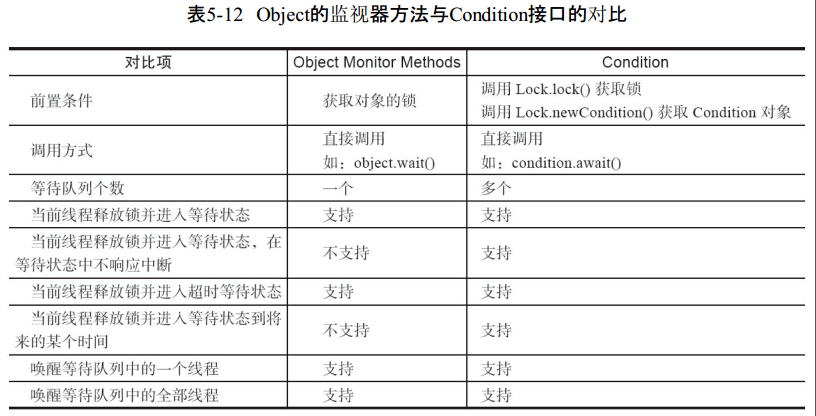目录
Condition接口
一、 Condition介绍及使用
Condition接口是为了与Lock配合实现等待/通知模式, 可以将Condition等待通知和Lock的关系 与 Object的等待通知和Synchronized的关系类比;
- Synchronized是通过锁对象即Object的wait() 和 notify() 实现等待通知;
- Lock 则可以通过Condition的await() 和 signal() 实现等待通知;
Object的监视器方法与Condition接口对比如下图:

Condition对象定义了等待通知两种类型的方法, Condition对象有Lock对象(调用newCondition()方法)创建, Condition对象依赖于Lock对象;
import java.util.concurrent.locks.Condition;
import java.util.concurrent.locks.Lock;
import java.util.concurrent.locks.ReentrantLock;
public class ConditionTest {
private static Lock lock = new ReentrantLock();
private static Condition condition = lock.newCondition();
public static void main(String[] args) throws InterruptedException {
new Thread(() -> {
try {
conditionWait();
} catch (InterruptedException e) {
e.printStackTrace();
}
}).start();
//Thread.sleep(100);
new Thread(() -> { conditionSignal(); }).start();
}
public static void conditionWait() throws InterruptedException {
lock.lock();
try{
System.out.println("start wait");
condition.await();
System.out.println("wait end");
}finally {
lock.unlock();
}
}
public static void conditionSignal() {
lock.lock();
try{
System.out.println("signal");
condition.signal();
}finally {
lock.unlock();
}
}
}
--- 输出:
start wait
signal
wait end
二、 Condition接口方法描述(基于jdk1.8)

三、 Condition实现分析
3.1 等待队列
以ConditionObject为例, ConditionObject是同步器AbstractQueuedSynchronizer内部类; 每个Condition对象都包含一个等待队列, 该队列是实现通知等待的关键; 队列节点使用的是AbstractQueuedSynchronizer.Node
public class ConditionObject implements Condition, java.io.Serializable {
private static final long serialVersionUID = 1173984872572414699L;
/** First node of condition queue. */
private transient Node firstWaiter; // 队首
/** Last node of condition queue. */
private transient Node lastWaiter; // 队尾
}
等待队列结构:

3.2 await()等待

调用Condition的await()方法, 会使当前线程进入等待队列并释放锁, 同时线程变为等待状态;
public final void await() throws InterruptedException {
if (Thread.interrupted())
throw new InterruptedException();
Node node = addConditionWaiter(); // 将当前线程添加到等待队列队尾
// 调用AbstractQueuedSynchronizer的方法, 释放掉当前线程持有的资源state, 并唤醒同步队列中下一个后继节点
long savedState = fullyRelease(node);
int interruptMode = 0;
while (!isOnSyncQueue(node)) {
LockSupport.park(this); // 最终还是依靠unsafe.park()实现的
if ((interruptMode = checkInterruptWhileWaiting(node)) != 0)
break;
}
if (acquireQueued(node, savedState) && interruptMode != THROW_IE)
interruptMode = REINTERRUPT;
if (node.nextWaiter != null) // clean up if cancelled
unlinkCancelledWaiters(); // 删除等待队列中等待状态不为CONDIITON的节点
if (interruptMode != 0)
reportInterruptAfterWait(interruptMode);
}
// 将当前线程添加到等待队列队尾
private Node addConditionWaiter() {
Node t = lastWaiter;
// If lastWaiter is cancelled, clean out.
if (t != null && t.waitStatus != Node.CONDITION) {
unlinkCancelledWaiters(); // 删除等待队列中等待状态不为CONDIITON的节点
t = lastWaiter;
}
// 将当前线程封装成Node对象添加到等待队列队尾
// 由于调用await()的前提是已经获取了锁, 所以下面操作不需要进行线程同步
Node node = new Node(Thread.currentThread(), Node.CONDITION);
if (t == null)
firstWaiter = node;
else
t.nextWaiter = node;
lastWaiter = node;
return node;
}
// 遍历等待队列, 删除队列节点中等待状态不为CONDITION(表示在Condition队列中等待)的节点
private void unlinkCancelledWaiters() {
Node t = firstWaiter;
Node trail = null;
while (t != null) {
Node next = t.nextWaiter;
if (t.waitStatus != Node.CONDITION) {
t.nextWaiter = null;
if (trail == null)
firstWaiter = next;
else
trail.nextWaiter = next;
if (next == null)
lastWaiter = trail;
}
else
trail = t;
t = next;
}
}
// AbstractQueuedSynchronizer中的方法, 释放掉当前线程持有的资源state, 并唤醒同步队列中下一个后继节点
final long fullyRelease(Node node) {
boolean failed = true;
try {
long savedState = getState(); // 获取当前线程所占有的资源
if (release(savedState)) { // 将资源释放, 并唤醒同步队列中的后继节点
failed = false;
return savedState;
} else { // 资源释放失败, 抛出异常
throw new IllegalMonitorStateException();
}
} finally {
if (failed) // 资源释放失败, 将该节点状态标记为CANCELLED(1)
node.waitStatus = Node.CANCELLED;
}
}
3.3 signal() 通知

- Condition的signal()方法, 将唤醒在等待队列中等待时间最长的节点(首节点), 在唤醒节点前, 会将节点移动到同步队列中;
public final void signal() {
if (!isHeldExclusively()) // 判断当前线程是否获取了锁; 未获取锁则抛出异常
throw new IllegalMonitorStateException();
Node first = firstWaiter;
if (first != null)
doSignal(first); // 唤醒头结点
}
// 将first节点添加到同步队列尾部, 如果失败则尝试唤醒下一个节点;
private void doSignal(Node first) {
do {
if ( (firstWaiter = first.nextWaiter) == null)
lastWaiter = null;
first.nextWaiter = null;
} while (!transferForSignal(first) &&
(first = firstWaiter) != null);
}
// 将node添加到同步队列尾部, 并尝试将其唤醒
final boolean transferForSignal(Node node) {
/*
* If cannot change waitStatus, the node has been cancelled.
*/
if (!compareAndSetWaitStatus(node, Node.CONDITION, 0))
return false;
/*
* Splice onto queue and try to set waitStatus of predecessor to
* indicate that thread is (probably) waiting. If cancelled or
* attempt to set waitStatus fails, wake up to resync (in which
* case the waitStatus can be transiently and harmlessly wrong).
*/
Node p = enq(node);
int ws = p.waitStatus;
if (ws > 0 || !compareAndSetWaitStatus(p, ws, Node.SIGNAL))
LockSupport.unpark(node.thread); // 最终还是依靠unsafe.unpark()实现的
return true;
}
- Condition的signalAll()方法, 相当于对等待队列中每个节点执行一次signal()方法;
/**
* Moves all threads from the wait queue for this condition to
* the wait queue for the owning lock.
*
* @throws IllegalMonitorStateException if {@link #isHeldExclusively}
* returns {@code false}
*/
public final void signalAll() {
if (!isHeldExclusively())
throw new IllegalMonitorStateException();
Node first = firstWaiter;
if (first != null)
doSignalAll(first);
}
/**
* Removes and transfers all nodes.
* @param first (non-null) the first node on condition queue
*/
private void doSignalAll(Node first) {
lastWaiter = firstWaiter = null;
do {
Node next = first.nextWaiter;
first.nextWaiter = null;
transferForSignal(first);
first = next;
} while (first != null);
}